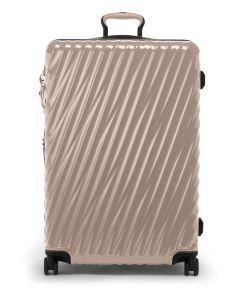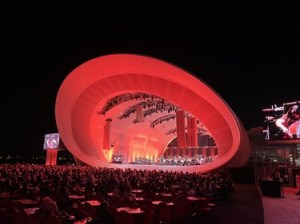DID YOU HEAR? The price of Super Bowl tickets dropped this week! That’s right, you and me will pay less for seats today than those jump-the-gun fans who got theirs ten days ago. The game’s in three days so we’ve got no time to lose! Let’s make our travel plans!
 I’m gonna surprise my wife. I mean, I’m the bigger football fan, yes, but she’ll be so proud of me for getting our game tickets for less! And to celebrate “all things her” I figure, why not splurge on the rest of the trip since I’m saving money on the game? Once in a lifetime, I’m telling myself. Heck, by the time the Super Bowl comes to Vegas a second time she and I could be dead!
I’m gonna surprise my wife. I mean, I’m the bigger football fan, yes, but she’ll be so proud of me for getting our game tickets for less! And to celebrate “all things her” I figure, why not splurge on the rest of the trip since I’m saving money on the game? Once in a lifetime, I’m telling myself. Heck, by the time the Super Bowl comes to Vegas a second time she and I could be dead!
 FIRST, new luggage. I want the two of us to be those people, where just a glance at their bags has you thinking, “Whoa, who are they?”. So, a quick trip to Tumi for a couple of their hard-shell packing cases ($1,500 per) and matching carry-on’s ($750). Getting the gold finish too, because you’ve got to look the part if you’re going to Vegas.
FIRST, new luggage. I want the two of us to be those people, where just a glance at their bags has you thinking, “Whoa, who are they?”. So, a quick trip to Tumi for a couple of their hard-shell packing cases ($1,500 per) and matching carry-on’s ($750). Getting the gold finish too, because you’ve got to look the part if you’re going to Vegas.
SECOND, airfare. I got me an itinerary lickety-split on Expedia, flying American. Leave Thursday, return Tuesday. Turns out we can’t get there direct since we live in the middle of nowhere but at least we can fly first class, for just $6,826, with only $600 in taxes and fees. Score!
 THIRD, transportation to the hotel. I’m not about to show up at the front doors with Tumi luggage in a rental car so it’s limo service for us! My choice: a modest SUV for two (well, three, including our private driver). I know, I know, I could’ve gone with the BMW stretch limo that seats twenty-five, but what are my wife and I gonna do – run laps around the inside of it? Besides, the SUV is described as “… for the VIP who prefers discretion” and that’s a great way to describe my wife. Round-trip: $375, with $75 in tips.
THIRD, transportation to the hotel. I’m not about to show up at the front doors with Tumi luggage in a rental car so it’s limo service for us! My choice: a modest SUV for two (well, three, including our private driver). I know, I know, I could’ve gone with the BMW stretch limo that seats twenty-five, but what are my wife and I gonna do – run laps around the inside of it? Besides, the SUV is described as “… for the VIP who prefers discretion” and that’s a great way to describe my wife. Round-trip: $375, with $75 in tips.
NOW THEN, the hotel. Gotta be big and flashy, right? Can’t be going to Vegas and the big game and staying at a Motel 6. Let’s go with the Bellagio. I don’t need a suite but I’d sure like a view of those lovely fountains. The hotel website quotes five nights for a “1 King Bed Fountain View” at $10,113, including $3,144 in resort fees. Yeah, I winced a bit with the five-figure quote but then the website flashed, Jackpot! This is today’s low rate! so I felt much better. The website also added a ten-minute timer on the rate but no worries – I booked it in less than five! Makes the $300 room service dinners seem like nothing, doesn’t it?

In the days leading up to the game I’ll pamper my wife a little. In fact, since I love the view of those Bellagio fountains so much, guess what? I can order up a couples massage right there in the room! Only $650 for the two of us, including $110 of gratitude to the masseuses. Then we’ll be nice and relaxed for a dinner at, say, the Eiffel Tower Restaurant at the Paris Hotel (and another view of those fountains). We’ll start with Casco Bay scallops ($32), followed by mixed greens ($38) and the “Queen’s Cut Beef Tenderloin Filet Mignon” ($138), with a plate of accompaniments and sauces ($42). We’ll finish up with a couple of the house special “Eiffel Tower soufflés” ($44), and wash it all down with a nice enough bottle of red ($80). Another $110 in tax and tips calls it a night.

Now wait a sec’. Since when does anyone in Vegas “call it a night” after dinner? So I thought about taking my wife to a big-name concert at the new Sphere but then it hit me. ‘O’ by Cirque du Soliel is right there in the Bellagio hotel! Two orchestra-center seats: $657, and only $93 tax/fees!
FINALLY… what I’ve been building to for hundreds of words now – Super Bowl XVIII. I’ve never been to Allegiant Stadium before and this’ll probably be my only visit, so… No, I didn’t go completely off the rails (like seats on the fifty or a sky box) but I do want to see the plays up close and personal so it’s got to be lower bowl, at least the 20-yard line. Oh man, what a relief! I found the last pair of tickets in Section C137 for $29,000 out the door (only $5,000 in service fees!) A flame emoji and a blinking “selling fast” sign had me sweating but I managed to get ’em before the next guy! Don’t forget, these same tickets would’ve cost me even more just a week ago. Can I find a bargain or what?
(Yawn… stretch…)
Oh, uh… hey… it’s Dave, your, uh, “weekly blogger”. Holy cow, let me tell you, I just woke up from the craziest dream. I was headed to the Super Bowl last-minute, see, and everything about the trip was the best Vegas had to offer. Hotel, dinner, show, game tickets – the works. Now that I’m awake, I’m wondering what all that fun would’ve cost me. $53,598 comes to mind for some reason but I’m sure I didn’t “spend” anywhere near that amount. Just a crazy dream. Anyway, sorry to write and run but I’ve got to return a call to my bank, asking about unusual activity on my credit card.
Some content sourced from the CNN Business article, “Super Bowl ticket prices have dropped but they still cost a fortune”, and Wikipedia, “the free encyclopedia”.


















































